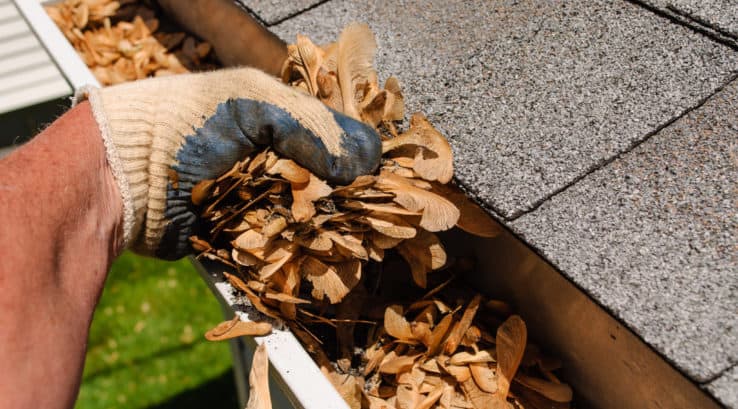A high-quality, well-maintained gutter system can go a long way toward protecting your home against costly water damage. Gutter problems can cause everything from roof leaks to wet basements, insect infestations, and even cracked foundations.
Here are the seven most common gutter problems homeowners should watch for:
1) Holes and Cracks
Over time, holes and cracks can develop in any gutter, resulting in leaks and your gutters not working properly. In many cases, small leaks can be repaired using gutter sealant, while multiple larger holes mean it’s time to consider investing in new, low-maintenance replacement gutters.
2) Not Enough Slope
If a section of gutter is not draining properly, you may want to check the angle, also known as pitch or slope. In general, your gutters should drop about 1/2-inch for every 10 feet of run. This creates a gentle slope that allows water to drain toward the downspouts in a steady stream.
3) Blocked Downspouts
One of the most common gutter problems is partially or fully blocked downspouts. Debris from the gutters can become lodged in the downspout, causing water to back up into the gutters during heavy downpours. The flow of water can also be limited if the downspout is crushed or bent.
4) Rotting Fascia
Fascias are straight, long boards that run along the area where the outer walls and roof meet. They’re often made of wood, which makes them particularly prone to damage from the elements, especially rot. Due to the fact they support the weight of guttering and the lowest row of tiles around the roof, heavy rainfall or the passage of time can lead to gutter problems.
5) Spikes Pulling Out
A major reason a gutter can come loose is a problem with the spikes that attach it to the fascia. Over time, wear, tear and changes in temperature can cause the holes the spikes slot into to expand and contract. Gutters bear a heavy load, including rain water, leaves and other debris. This combination can cause guttering to come loose or pull away from your property entirely.
6) Vegetation in the Gutters
Organic materials such as leaves and twigs can accumulate in your gutters, and over time, this material composts down into moist, fertile soil. When tiny airborne seeds land in soil-filled gutters, they quickly sprout. Not only can these gutter plants block the flow of water, but they can add significant weight, causing the gutters to pull away from the fascia board.
7) Separating Joints
In areas where a long stretch of gutter is needed, it’s common to find multiple joints connecting shorter sections together. Over time, these joints can separate due to debris in the gutter, heavy water flow, and age-related deterioration. This can result in the gutters not working properly because most of the water will simply drop downward at the joints.
8) Insect and Bird Nests
Bird and insect nests are other common causes of gutter problems. When a gutter is not draining properly, the standing water can quickly become a haven for mosquitoes. Birds, bees, and wasps often find that dry, well-draining gutters make the ideal environment for their nests. Due to the risk of injury and federal laws that protect the nests of native birds, nest removal is best left to the experts.
9) Backflow
Backflow occurs when rain travels down the roof and behind the gutters, rather than falling into the gutter troughs. This can occur when the drip edge is damaged, missing, or improperly installed, leaving a gap between the gutter and the fascia board. Backflow can also be a problem if the gutter shifts out of position due to missing or damaged fasteners.
Eliminate Gutter Problems
While some common gutter problems such as clogs can usually be prevented with regular maintenance, other problems can only be eliminated by upgrading to a new, high-quality gutter system.
Here at Thompson Creek, our innovative seamless, clog-free gutter system is designed to virtually eliminate all gutter problems. Contact us today to learn more about our American-made, maintenance-free gutter systems.


